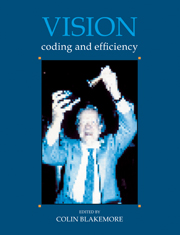Book contents
- Frontmatter
- Contents
- List of Contributors
- Preface
- Reply
- Acknowledgements
- Concepts of coding and efficiency
- 1 The quantum efficiency of vision
- 2 Coding efficiency and visual processing
- 3 Statistical limits to image understanding
- 4 The theory of comparative eye design
- Efficiency of the visual pathway
- Colour
- Brightness, adaptation and contrast
- Development of vision
- Depth and texture
- Motion
- From image to object
- Index
2 - Coding efficiency and visual processing
Published online by Cambridge University Press: 05 May 2010
- Frontmatter
- Contents
- List of Contributors
- Preface
- Reply
- Acknowledgements
- Concepts of coding and efficiency
- 1 The quantum efficiency of vision
- 2 Coding efficiency and visual processing
- 3 Statistical limits to image understanding
- 4 The theory of comparative eye design
- Efficiency of the visual pathway
- Colour
- Brightness, adaptation and contrast
- Development of vision
- Depth and texture
- Motion
- From image to object
- Index
Summary
Improving the efficiency of vision brings distinct advantages. Improved spatial resolution and the better detection of small intensity differences allows an animal to resolve more objects and to see objects at a greater distance. These improvements in accuracy and resolution extend both the range and the richness of perception, so providing a greater return for an animal's investment in eye and brain. It follows that coding efficiency, that is the accuracy and fidelity with which information is gathered by the eye, and transmitted and processed by neurons, is an important biological factor. Consequently, the need for efficiency must shape visual processing, and considerations of efficiency can guide our understanding of vision (e.g. Hecht, Shlaer & Pirenne, 1942; Rose, 1972; Barlow, 1964). The dictates of coding efficiency are illustrated by our work on the blowfly retina (Laughlin & Hardie, 1978; Laughlin, 1981; Srinivasan, Laughlin & Dubs, 1982; Laughlin, Howard & Blakeslee, 1987). Both our experimental-theoretical approach to retinal coding in the blowfly, and our major conclusions have recently been reviewed (Laughlin, 1987; 1989). In this article I will briefly summarise our arguments and explore some of the general implications of the finding that retinal circuits are designed to promote coding efficiency.
The constraints imposed upon vision by the properties of natural images and the construction of neurons are readily apparent in the retina. A detailed optical image is projected onto the photoreceptors and transformed into the first neural image – the distribution of receptor potentials across the photoreceptor mosaic. The properties of natural signals and photoreceptors severely limit the amplitude of the signal in this electrical “image”.
- Type
- Chapter
- Information
- VisionCoding and Efficiency, pp. 25 - 31Publisher: Cambridge University PressPrint publication year: 1991
- 1
- Cited by



